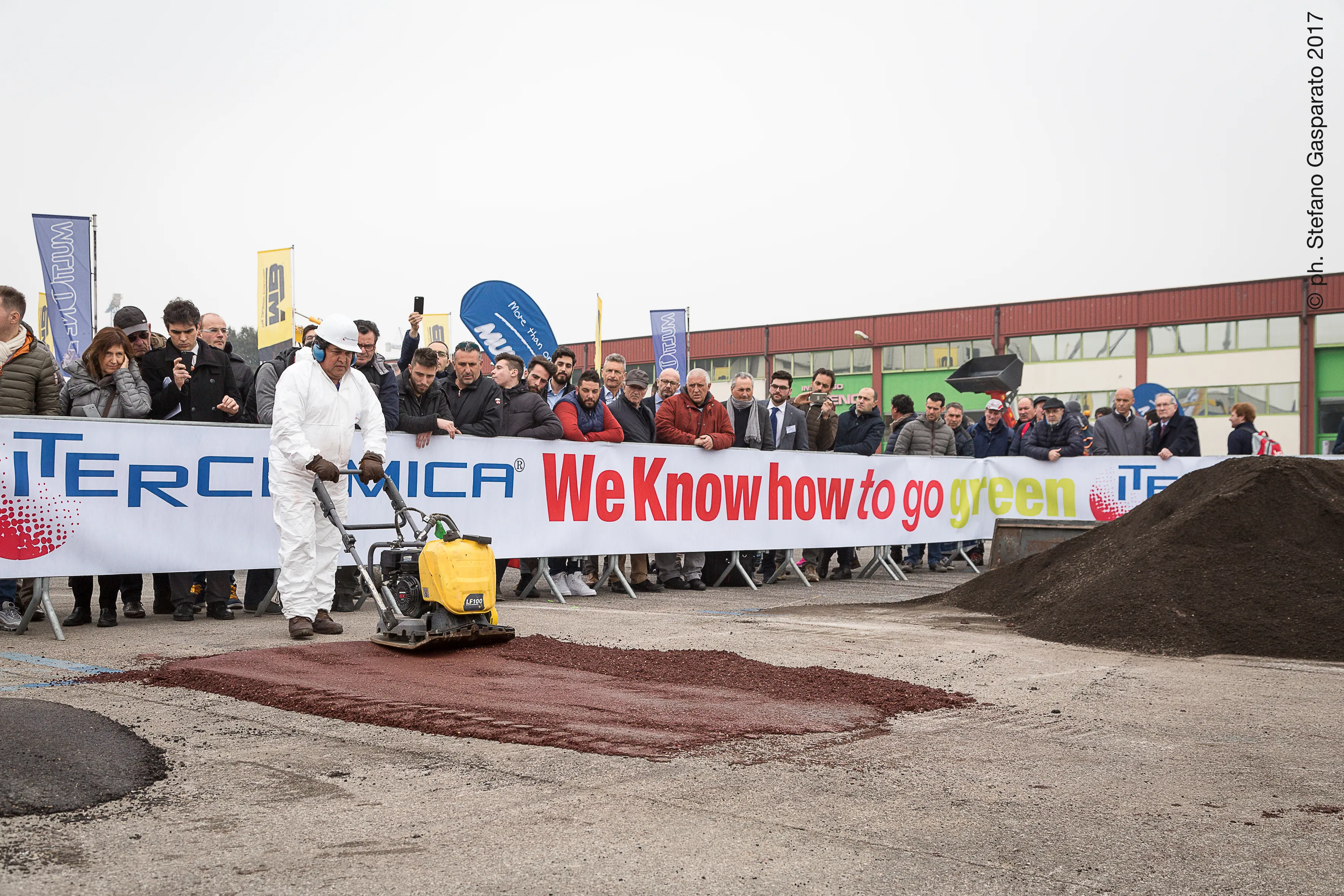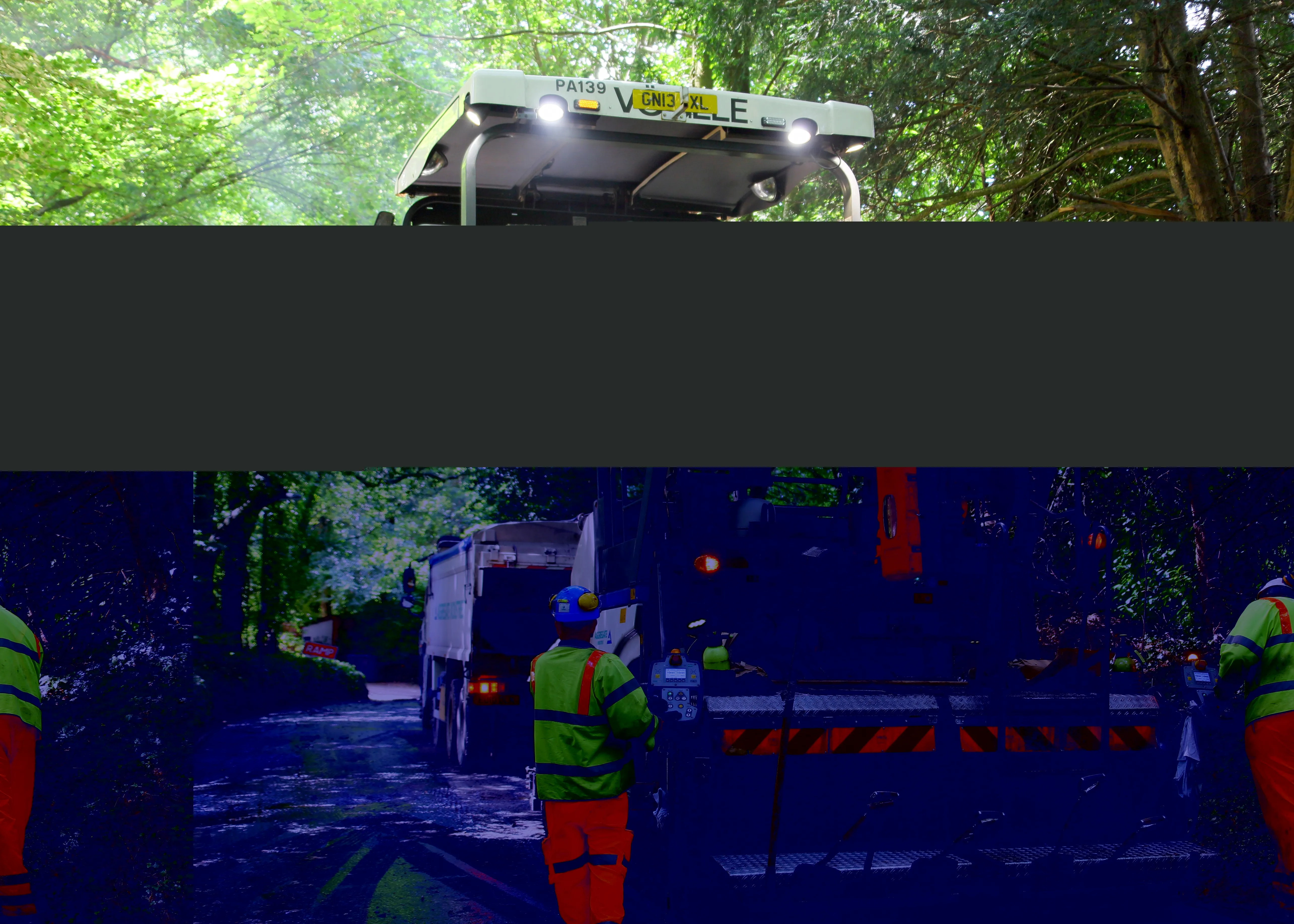
Like many of its European neighbours, much of Italy’s road network is in dire need of love and attention. This was a constant theme for the
It’s perhaps not surprising that there were many road repair and patching technologies to be seen. With the Italian Government's green procurement drive, recycling was another strong theme and recent changes to specifications mean that warm mix asphalt is a more interesting prospect for Italian contractors now.
Iterchimica
Chemical specialist
Iterchimica used the show to highlight a new use for its cold rejuvenator Iterlene ACF 1000HP Green. Originally designed for patching up potholes, an update to the product’s formulation now means it can be used for resurfacing bike lanes and roads with low traffic. Live demonstrations in one of Asphaltica’s outside areas saw road planings mixed with Iterlene ACF 1000HP Green together with colouring and then laid down.
Iterchimica has designed the rejuvenator, which is a hydrocarbon binder with plastifiers and vegetal flux oils, so that it can be used with 100% RAP. The required dosage of rejuvenator, which comes in a liquid form, is between 2% and 2.5% of RAP, by weight.
Iterlene ACF 1000HP Green was launched back in 2013 and is now Iterchimica’s most popular cold rejuvenator. According to Iterchimica vice president Alessandro Giannattasio, it has been used worldwide in countries including Greece, Lithuania, Germany and Brazil.
The live demonstrations at Asphaltica generated a lot of interest, according to Giannattasio: “We have already sent out quotes after receiving price requests collected thanks to the demonstrations at Asphaltica.”
Ingevity
“There’s interest from Italy because
One road authority which is taking a pro-active approach to solving these problems is that of Rheinland-Pfalz. On a 4km stretch of the very heavily trafficked B51 highway, three lanes are each being paved in a different way to investigate the potential of Evotherm.
The first lane was a reference section, laid during the traditional paving season. The second was laid in December when temperatures dropped as low as -10°C, mixing at standard hot-mix temperatures and with the addition of Evotherm. The third and final section is due to be laid in March or April this year, with the mixing temperature lowered by 30°C; a standard warm-mix.
These sections are being closely monitored.
Though the final section is yet to be laid the road administration in Rheinland-Pfalz is so pleased with the results so far that it has specified the use of Evotherm on two other sections of road so that paving could be completed in December, according to Falvo.
Massenza
On its Asphaltica stand,
The first 12 months have been successful according to director Diego Massenza: “In the last year, Strassmayr doubled its turnover compared to the previous year. We are happy with sales made in a number of countries including the US, Russia and Eastern Europe.”
The patcher is one of Strassmayr’s best-selling machines, together with the RWK 600/500 cracksealing machine and the BF 290 road widener have also proved popular. One of the selling-points of the patcher is that it contains all the equipment and materials needed to clean out and repair cracks in the road, and allows a one-man repair operation.
“It has a front-operating boom that is operated by the driver from the cabin, using the joystick so that he can drive and repair without having to stop between operations,” said Mazzenza. “That’s a cost-effective solution, especially in European countries where the cost of labour is high.” Roads can be reopened to traffic just 15 minutes after the repair is complete, says Massenza.
Massenza and Strassmayr are currently working on new machines that combine technology from the two firms: “We are spending a lot of time and resource on new machines for repairing roads,” said Massenza. “This is a particular need in Europe, where the road networks have been neglected for too long.”
Street Life
Street Life was at Asphaltica to tell the market about its additive Carbo Long Working (CLW) which it claims can do several jobs at once.
“With one product you can have the actions of three of the best additives in one solution,” said general manager Giusy Ture. According to Ture, CLW allows lower production temperatures, increases the amount of RAP that can be used and acts as an adhesion promoter.
The original version of this product, Carbonxide, was invented for the steel sector by Ture’s father. However research carried out at the Marche Polytechnic University in Ancona revealed that it had antioxidant powers for bitumen too.
Rome’s Piazza del Risogimento was one of the first places to benefit from CLW, with a trial area laid four years ago still in prime condition, while a conventionally-laid comparison section has deteriorated, said Ture. CLW is currently only sold in Italy, but Street Life hopes to extend its market from this year, first into Europe and then worldwide.
Hansoo Natech
Korean firm Hansoo Natech was attracting a lot of attention at its stand with a product called SPEED RO-pocket. Launched two years ago in Korea, Speed Ro-pocket is a patching material in a bag which its maker claims will produce a repair that lasts for a year.
“It contains asphalt for cold work, you don’t need to heat it,” explained Hansoo Natech president Park Joung Ho. “It contains 100% recycled asphalt and some elements that are activated by the pressure of vehicles passing over; it becomes a sticky liquid like glue.”
Hansoon Natech, which produces a number of road repair technologies, already trades in Canada, Chile, the Phillipines, Taiwan and Japan and is currently looking for distributors or resellers in Europe.
Officina dell’Ambiente
The political will in Italy to use more recycled materials has boosted the fortunes of Officina dell’Ambiente, a company which creates products from the bottom ash produced by waste incinerators. Established in 2001, the company produces its Matrix aggregate for a number of building applications and in the past three years has added aggregates for pavement mixes to its list.
“Two years ago the new administration mandated the use of recycled material in construction, including roads, so the market is changing a lot,” said Alessandro Massalin, Officina dell’Ambient’s commercial director.
Matrix, which is cheaper than natural aggregate, can be used to replace 10% of the aggregate in an asphalt mix. Officinal dell’Ambiente has invested a lot of resource in ensuring that its product is stable and repeatable and in obtaining a range of certification including EPD (Environmental Product Declaration).
Italy’s second-, third- and fourth-ranked road contractors already use Matrix, said Massalin. And the biggest contractor had been talking to Officina dell’Ambiente at the show.









